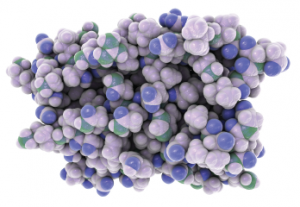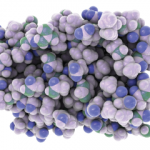Immunology insights for rheumatologists & rheumatology professionals

Representation of the molecular structure of interferon α.
Kateryna Kon / shutterstock.com
“It can be difficult to predict the long-term impact of research at the time it is being performed, but over time, as knowledge of a field grows, that impact can be tremendous,” says Peggy Crow, MD, a senior scientist and Mary K. Crow Chair of Immunology and Inflammation Research at the Hospital for Special Surgery, and professor of medicine at Weill Cornell Medical College, both in New York.
Dr. Crow is the co-author of a review that is part of a series on immunology for rheumatologists launched recently in Arthritis & Rheumatology (A&R).1 In this new installment, Dr. Crow, Mikhail Olferiev, MD, and Kyriakos Kirou, MD, DSc, review advances in interferon (IFN) research related to the pathogenesis and treatment of systemic lupus erythematous (SLE) and other systemic rheumatic diseases.2
Insights for Rheumatologists
“The review identifies many of the investigators who have been critical in defining type I interferon and the impact of interferon research on advances in science and medicine,” explains Dr. Crow. “We review how interferon is induced and regulated, and its impact on host defense against virus infection, as well as its role in the pathophysiology of autoimmune, rheumatic diseases, particularly SLE.
“Understanding the history and progress of science allows us to have a deeper understanding of the underlying mechanisms of the diseases that we treat,” Dr. Crow says. “In the case of interferon, it is remarkable how the study of this cytokine family has generated essential knowledge of the role cytokines play in host defense and disease, and the essential aspects of biology that have, over time, led to identification of the type 1 interferon receptor, the [Janus kinase (JAK) signal transducer and activator of transcription (STAT)] pathway, the interferon-stimulated genes, the interferon regulatory factors and the plasmacytoid dendritic cell as an important cellular source of interferon.

Dr. Peggy Crow
“In addition to describing the trajectory of interferon research and its broad impact on understanding cytokine biology, the review lists many of the therapeutic agents currently in development or approved for treatment of rheumatic diseases that derive from research on the interferon pathway,” Dr. Crow says.
Research & Immunology
From the discovery of IFN in the 1950s to the 2021 U.S. Food & Drug Administration (FDA) approval of the anti-IFN-α/β receptor (IFNAR) antibody anifrolumab for the treatment of moderate to severe SLE, the review describes key advances in IFN research. It includes informative tables, detailed images and legends, and many references.
The authors begin their review by discussing early IFN research and its impact on immunology. By the 1960s, researchers had defined gene products representing leukocyte IFN and fibroblast IFN—later together called type I IFN. Today, “12 unique IFN-α protein products are recognized, along with single-gene products for IFN-β, κ, ε and ω,” and “products of the IFN-I family are distinguished from IFN-γ,” initially called immune or type II IFN, the authors write.
Subsequent discoveries on how the cellular effects of IFN-I were mediated—IFN-I receptor characterization, identification of the JAK/STAT signaling pathway, description of the IFN-I stimulated gene (ISG) program and the elements that control ISG expression—remain “relevant to current consideration of the therapeutic targets that are likely to be most efficacious for management of disease in patients with systemic autoimmune diseases,” Crow et al. explain.
SLE Manifestations
According to the review, research completed during the 1970s identified IFN-I in the blood of patients with SLE. By the late 1980s, the significance of the IFN-I pathway and the specific role of IFN-α were established. Studies found links between IFN-I levels and cutaneous manifestations, the degree of fever and a history of vascular disease.
“Based on the symptoms demonstrated by patients receiving leukocyte IFN for treatment of malignancy, including fever, fatigue, mild hair loss and leukopenia, investigators suspected a role for IFN-I in the clinical manifestations of SLE,” Crow et al. write.
Researchers found higher IFN-α levels in the cerebrospinal fluid of patients with lupus psychosis, with those levels dropping as psychosis resolved. The link between IFN-I and both cutaneous lupus and lupus nephritis followed reports of an accumulation of plasmacytoid dendritic cells (pDCs), which produce IFN-α, along with sarcoplasmic myxovirus-resistance protein A (MxA), in skin and renal glomeruli. Researchers also discovered IFN-I and ISG expressions in the kidneys of patients with lupus nephritis, as well as in the synovial tissue of patients with both lupus and arthritis.
Genetics
Crow et al. next cover IFN-I pathway activation as a central mechanism in the pathogenesis of SLE, IFN-I production drivers and lessons from interferonopathies.
Several research groups used microarray platforms to characterize the gene expression profile of blood from patients with SLE, “showing elevated expression of transcripts,” including some that “could be interpreted as induced by either IFN-I or IFN-II, although there can be considerable overlap in the genes regulated by those two cytokine families,” the authors write.
“Defining the upstream drivers of IFN-I production in SLE requires identification of the nature of the relevant stimuli, presumed to be nucleic acids, their receptors and the signaling pathways engaged prior to transcription of IFN-I,” they continue.
The researchers highlight “the contribution of SLE-associated genetic variants” to several components of the toll-like receptor (TLR) 7 pathway, which supported findings on the role of “RNA-containing stimuli as drivers for the striking expression of IFN-α and the resulting activation of the JAK-STAT pathway and induction of ISGs that are common features of SLE.”
Additional potential drivers of IFN-I production in SLE relate to the genetic variants associated with Aicardi-Goutières syndrome (AGS). “Mutations associated with impaired regulation, degradation or sensing of cytosolic RNA or DNA in patients with AGS result in sustained high levels of IFN-α, production of autoantibodies, and cutaneous and central nervous system pathology,” Crow et al. explain.
Continued Research
The FDA-approved IFNAR antibody anifrolumab signifies “the first targeted therapy relevant to treatment of patients with systemic autoimmune disease and specifically directed to the IFN-I pathway,” write Crow et al. However, “targeting IFNAR is only one of the many potential therapeutic approaches that are products of the long and highly impactful history of IFN-I research.”
The review highlights several areas of current research that may help with treatment strategies, including the role of nucleic acids recognized by cytosolic sensors, sorting ISGs to reflect their relevant drivers and the contribution of IFN-I to the varied clinical manifestations of SLE and other systemic rheumatic diseases, such as Sjögren’s disease and dermatomyositis.
“We hope the reader will recognize and respect the impressive efforts made by so many dedicated researchers, working over many decades, to characterize the interferon pathway and its impact on the response to virus infection as well as its role in disease,” Dr. Crow says. “That research has fostered a broad range of essential insights into biologic pathways, as well as opportunities for therapeutic intervention in patients with rheumatic disease.”
Katie Robinson is a medical writer based in New York.
References
- Bucala R, Solomon DH. Immunology for the rheumatologist: A&R introduces a new problem-based immunology review series with great educational potential. Arthritis Rheumatol. 2024 Jan;76(1):9–10.
- Crow MK, Olferiev M, Kirou KA. Standing on shoulders: Interferon research, from viral interference to lupus pathogenesis and treatment. Arthritis Rheumatol. 2024 Mar 18. [accepted; online first]



